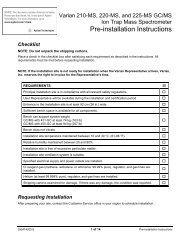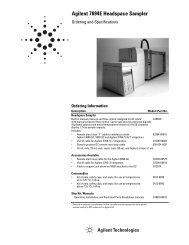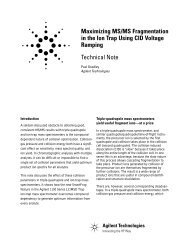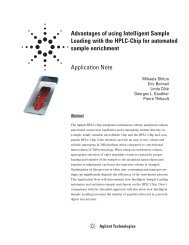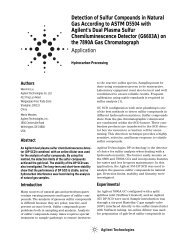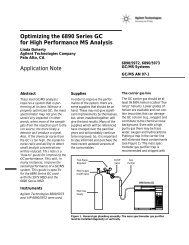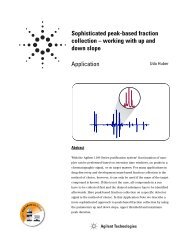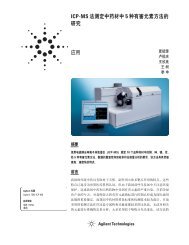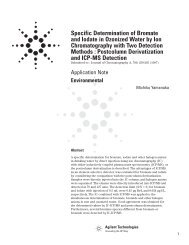GC/MS Analysis of Polybrominated Flame Retardants - Agilent ...
GC/MS Analysis of Polybrominated Flame Retardants - Agilent ...
GC/MS Analysis of Polybrominated Flame Retardants - Agilent ...
Create successful ePaper yourself
Turn your PDF publications into a flip-book with our unique Google optimized e-Paper software.
Abstract<br />
<strong>Polybrominated</strong> diphenyl ethers (PBDE) are used as<br />
flame retardants in such diverse products as textiles, circuit<br />
boards, and computer covers. Through the disposal<br />
<strong>of</strong> those products in landfills, PBDEs have found their<br />
way into the environment. Studies have shown that<br />
PBDEs have detrimental health effects.<br />
Detection and quantitation <strong>of</strong> these compounds is complicated<br />
by their intrinsic properties: high boiling points<br />
and low thermal stability. This paper describes development<br />
<strong>of</strong> a suitable <strong>GC</strong>/<strong>MS</strong> method to analyze PBDEs.<br />
<strong>Agilent</strong>'s DB-XLB was found to be the column <strong>of</strong> choice<br />
for this demanding analysis.<br />
Introduction<br />
The presence <strong>of</strong> polybrominated diphenyl ethers<br />
(PBDE) throughout the world environment has<br />
attracted the attention <strong>of</strong> scientists around the<br />
world. PBDEs are used as flame retardants in<br />
many commercial products, like textile and furniture,<br />
and in circuit boards in consumer electronics,<br />
like TVs and computers. As more and more<br />
<strong>of</strong> these abundant consumer products find their<br />
way into landfills, PBDEs have been found in our<br />
drinking water supplies (1). One alarming study<br />
predicts that the level found in human breast<br />
milk <strong>of</strong> North American women appear to double<br />
every two to five years (2).<br />
Exposure <strong>of</strong> personnel working with computers<br />
is also a concern (3). While the toxicology <strong>of</strong><br />
PBDE is still under investigation, research has<br />
established that it is persistent, bioaccumulative,<br />
and toxic. There is evidence that PBDE can<br />
cause neurotoxic effects similar to the nowbanned<br />
polychlorinated biphenyls (PCB).<br />
Just like PCBs, there are 209 PBDE congeners<br />
(Fig. 1), and they are named in analogy to PCBs<br />
(4). However, only 7 congeners comprise about<br />
95% <strong>of</strong> all detected peaks (5). These major congeners<br />
are (by IUPAC number): 28, 47, 99, 100,<br />
153, 154, and 209.<br />
Figure 1: Structure <strong>of</strong> Polybominated diphenylethers (PBDE)<br />
Until recently, the lack <strong>of</strong> available standards<br />
and individual congeners has made accurate<br />
quantitation difficult (6). Now, practically all<br />
individual congeners are commercially available.<br />
For analysis by <strong>GC</strong>, several different stationary<br />
phases have been used. However, run times are<br />
generally quite long, and <strong>of</strong>ten not all critical<br />
congeners are sufficiently resolved. This study<br />
investigates the use <strong>of</strong> the DB-XLB (<strong>Agilent</strong><br />
Technologies, Folsom CA), a proprietary lowpolarity,<br />
low-bleed stationary phase with high<br />
thermal stability. This column has been shown<br />
to be an excellent choice for detailed, high-resolution<br />
analysis <strong>of</strong> PCB congeners by <strong>GC</strong>/<strong>MS</strong> (7).<br />
The structural similarities between PCBs and<br />
PBDEs suggest that the DB-XLB should be an<br />
excellent choice for separation <strong>of</strong> PBDEs as well.<br />
Different column dimensions, injections modes,<br />
and temperature programs were evaluated to<br />
obtain an analysis method that was optimized<br />
for speed, sensitivity, and resolution.<br />
Materials and Methods<br />
The PBDE standards were purchased from<br />
Cambridge Isotope Labs (Andover, MA). Samples<br />
<strong>of</strong> commercial flame retardants were a generous<br />
gift from Dr. Mehran Alaee <strong>of</strong> Environment<br />
Canada.<br />
<strong>GC</strong> Conditions for all chromatograms:<br />
<strong>GC</strong>:<br />
<strong>Agilent</strong> 6890 Gas Chromatograph<br />
with 7673 Autosampler and<br />
ChemStation S<strong>of</strong>tware<br />
Column: DB-XLB, 30 m x 0.25 mm I.D. x 0.1 µm<br />
(<strong>Agilent</strong> Part Number: 122-1231)<br />
Carrier Gas: Helium at 38 cm/sec at 100ºC<br />
(1.2 mL/min), constant flow mode<br />
Oven:<br />
100ºC for 1 min;<br />
20ºC/min to 340ºC, hold for 12 min<br />
Injector:<br />
Cool-on-column, oven-track mode,<br />
0.5 µL<br />
Detector:<br />
<strong>Agilent</strong> 5973 <strong>MS</strong>D; transfer line at<br />
325º C, EI SIM (ions monitored:<br />
231.8, 248.0, 327.9, 398.6, 400.5, 405.8,<br />
845.7, 563.6, 643.5, 721.4, 799.3)<br />
2<br />
Note: Mono-through octa-substituted homologs detected using SIM at the most<br />
intense <strong>of</strong> the M + , (M+2) + , (M+4) + , (M+6) + , or (M+8) + masses, with a data<br />
acquisition rate <strong>of</strong> approx. 3 cycles/second. Monitoring the molecular ion was<br />
not possible above octa-substituted PBDEs due to the limitations <strong>of</strong> the mass<br />
range <strong>of</strong> the 5973 instrument (maximum <strong>of</strong> m/z 800).<br />
Decabromodiphenylether was detected by monitoring significant fragments <strong>of</strong><br />
high abundance: m/z 231.8, 398.6, 400.5, and 799.3.



